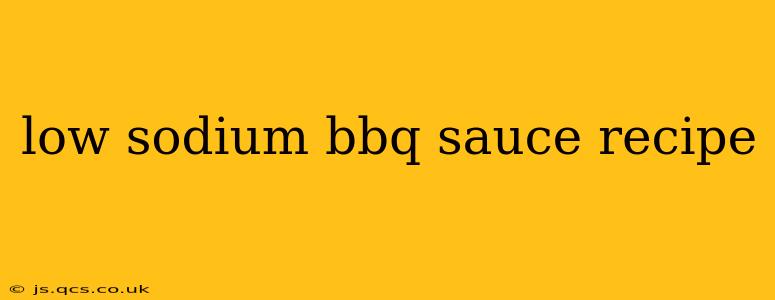Barbecue sauce is a quintessential summer staple, adding a burst of flavor to ribs, chicken, and even vegetables. However, many commercially available BBQ sauces are surprisingly high in sodium. This recipe provides a delicious, low-sodium alternative that won't compromise on taste. You can easily adjust the spices to suit your preferences, creating your perfect low-sodium BBQ sauce.
Why Choose a Low-Sodium BBQ Sauce?
Many people are increasingly aware of the need to reduce their sodium intake for better heart health. High sodium consumption is linked to high blood pressure, which increases the risk of stroke and heart disease. Opting for a low-sodium BBQ sauce is a simple way to control your sodium intake without sacrificing flavor.
Ingredients for Low-Sodium BBQ Sauce
This recipe yields approximately 2 cups of sauce.
- 1 large onion, finely chopped
- 2 cloves garlic, minced
- 1 (28 ounce) can crushed tomatoes, no salt added
- 1 cup ketchup (low-sodium or no-salt-added)
- 1/2 cup apple cider vinegar
- 1/4 cup brown sugar (or to taste, adjust for sweetness)
- 2 tablespoons Worcestershire sauce (low-sodium)
- 1 tablespoon smoked paprika
- 1 tablespoon chili powder
- 1 teaspoon ground cumin
- 1 teaspoon onion powder
- 1 teaspoon garlic powder
- 1/2 teaspoon black pepper
- 1/4 teaspoon cayenne pepper (optional, for heat)
Instructions for Making Low-Sodium BBQ Sauce
-
Sauté the Aromatics: In a large saucepan over medium heat, sauté the chopped onion and minced garlic in a small amount of olive oil until softened, about 5-7 minutes. Avoid browning.
-
Combine Ingredients: Add the crushed tomatoes, ketchup, apple cider vinegar, brown sugar, Worcestershire sauce, smoked paprika, chili powder, cumin, onion powder, garlic powder, black pepper, and cayenne pepper (if using) to the saucepan.
-
Simmer the Sauce: Bring the mixture to a gentle simmer, then reduce heat to low. Cover and simmer for at least 30 minutes, or up to 1 hour, stirring occasionally. The longer it simmers, the richer the flavor will become.
-
Blend (Optional): For a smoother consistency, use an immersion blender to partially or fully blend the sauce. If you prefer a chunkier texture, skip this step.
-
Taste and Adjust: Taste the sauce and adjust seasonings as needed. You may want to add more brown sugar for sweetness, cayenne pepper for heat, or a touch more vinegar for tanginess.
-
Cool and Store: Allow the sauce to cool completely before storing in an airtight container in the refrigerator. The sauce will thicken as it cools.
Frequently Asked Questions (FAQs)
How long will the low-sodium BBQ sauce last in the refrigerator?
Your homemade low-sodium BBQ sauce will generally last for about a week in the refrigerator when stored properly in an airtight container.
Can I freeze low-sodium BBQ sauce?
Yes, you can freeze low-sodium BBQ sauce. Allow it to cool completely before transferring it to freezer-safe containers. Frozen BBQ sauce will keep for 2-3 months.
What can I use as a substitute for brown sugar?
If you don't have brown sugar, you can substitute with granulated sugar or maple syrup. Adjust the amount to your liking, as maple syrup is sweeter than brown sugar. Consider using a sugar substitute if you are watching your sugar intake.
Can I make this recipe without ketchup?
While ketchup adds a base flavor and texture, you could potentially omit it. However, you might need to adjust other ingredients to achieve the desired consistency and taste. Consider adding more crushed tomatoes or a tomato paste alternative.
How can I make this BBQ sauce spicier?
To increase the spice level, add more cayenne pepper, or include a few dashes of your favorite hot sauce.
This low-sodium BBQ sauce recipe offers a delicious and healthy alternative to commercially available options. Enjoy experimenting with different spices and adjusting the ingredients to create your own signature flavor profile. Remember to always check your labels to ensure you are using low-sodium or no-salt-added ingredients.
